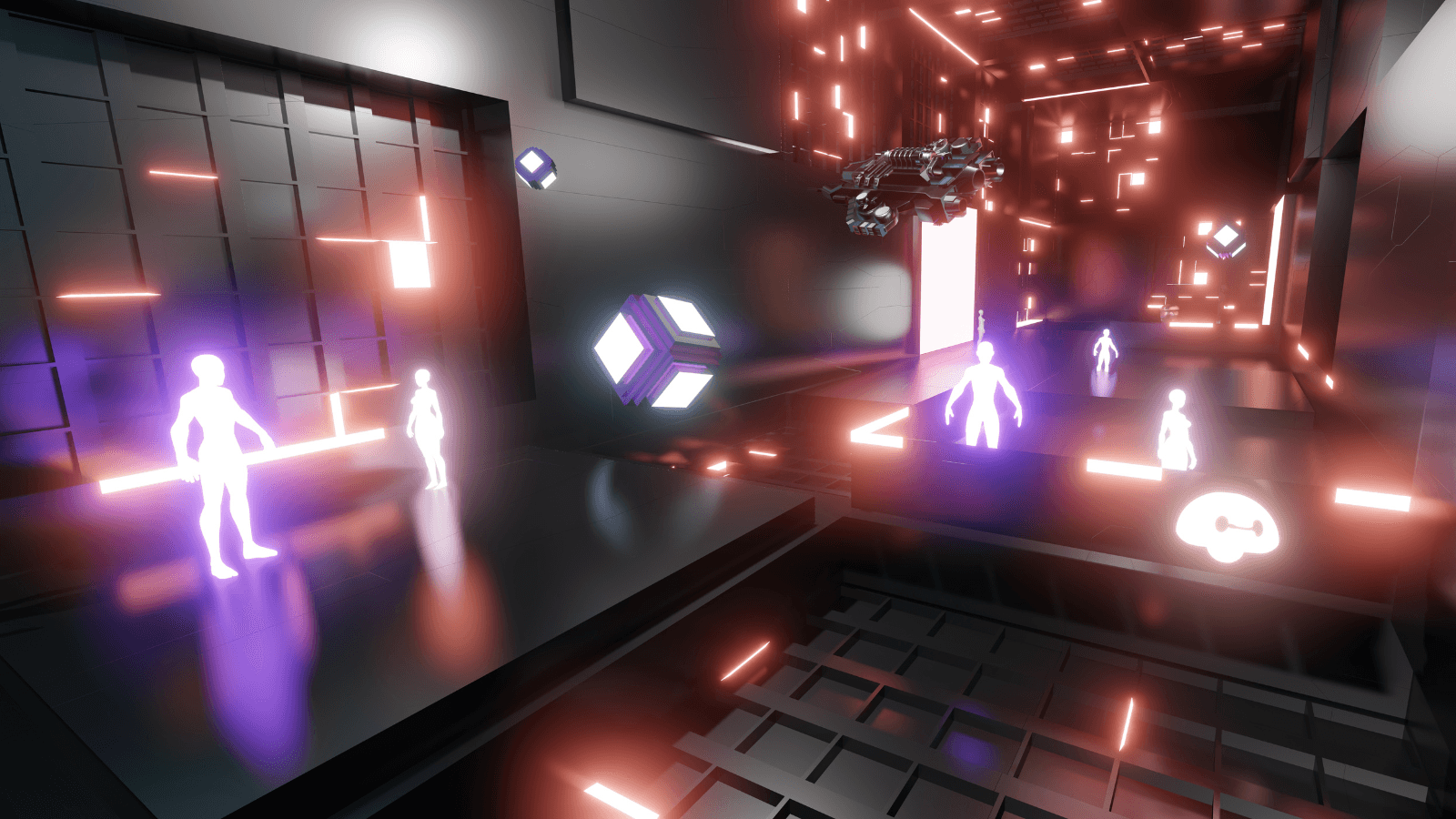Back to Blog
What's Needed for Metaverse Mass Adoption
Oct 24, 2023
Callum Moates
The metaverse or 3D internet is a digital universe where people can work, play, and socialize in immersive virtual environments. Companies, entrepreneurs, and tech enthusiasts are investing heavily in creating the foundation for this digital frontier. However, for the metaverse to truly reach its potential and become a part of our everyday lives, it must cater to the masses.
This article will explore the essential elements needed for metaverse mass adoption and examine the challenges and opportunities ahead in realizing this vision. The metaverse must address multiple factors to turn mainstream, from robust infrastructure, user-friendly interfaces, ethical considerations, and mechanisms to encourage user-generated content.
The technology infrastructure
Robust technological infrastructure is pivotal for the mass adoption of the metaverse to ensure computation, connectivity, and performance demanded by real-time experiences in the 3D internet. It serves as the bedrock upon which the immersive experiences and rich interactions can flourish by providing high-quality graphics, computer vision, and physics simulations.
Several critical aspects of this infrastructure stand out as essential contributors to the metaverse's success:
High-speed internet: Fixed wireline fiber networks are suited for the initial demands of the metaverse, whereas wireless networks might fall short. While contemporary wireless networks like 5G/LTE are likely capable of providing sufficient download speeds for consumer metaverse interactions, they might struggle with the upload speeds and latency demands, especially for business and industrial applications in the 3D internet. To effectively cater to metaverse experiences and to ensure scalability for future demands, telecom operators need to increase the density of their wireless cell tower networks. Additionally, adopting innovative wireless technologies that can identify and adjust to varying data types and volumes will be crucial.
Low-latency connections: Low latency ensures that interactions within the 3D internet feel seamless and natural and will be essential to growing the metaverse. Users should be able to move, communicate, and interact with virtual objects in real time without noticeable delays or lags. Low-latency connections also enhance the realism of virtual experiences, making them more engaging and immersive. For instance, reduced latency enhances the metaverse's ability to depict details such as micro-expressions, provide seamless VR visuals, and elevate the user experience. Ideally, the metaverse should operate at a latency of 133ms and even 83ms for hardcore gamers, as stated in a Citi GPS report. However, current systems only achieve between 170 to 180ms.
Scalable cloud computing: The metaverse demands immense computational power and storage capacity to create, host, and deliver virtual environments and experiences. Scalable cloud computing solutions are essential for accommodating the vast data and processing power required to support the metaverse's growth and enabling developers to efficiently create and scale their metaverse projects. Chips needed for cloud computing must possess a greater die size and offer enhanced power to grow the 3D internet. Decentralized cloud architecture will also be a way to provide cheaper and better performance. Alternatively, the emphasis on achieving ultra-low latency for virtual-world applications will also increase edge data centers in driving the metaverse.
Landvault Publish allows creators to publish their metaverse experiences directly on the web, accessible through a simple link click across mobile, desktop, or Apple Vision Pro. This offering not only simplifies the distribution process but also promotes accessibility. Landvault Publish uses scalable cloud infrastructure to ensure that metaverse content is readily available to a broad audience, regardless of their location or device specifications. The service helps democratize metaverse development by lowering the entry barriers for creators.

User-friendly interfaces
The development of intuitive and user-friendly interfaces is paramount for the mass adoption of the metaverse. To realize the metaverse's potential as a mainstream platform for work, play, and social interaction, it must be accessible and enjoyable to a diverse group of people across all ages and backgrounds. This inclusivity ensures that a broader demographic can participate in the 3D internet, making it a more vibrant and versatile digital space.
Here are some key considerations regarding the importance of intuitive interfaces and the development of interface technologies in the metaverse.
Accessibility: The metaverse should be designed to accommodate users from various age groups and backgrounds. Intuitive interfaces ensure that individuals with varying levels of digital literacy can easily navigate the virtual world. Landvault Publish eliminates the need to download an application and creating a simple click-to-access process doesn’t require any technical expertise and lowers the barriers to entry. This inclusivity broadens the metaverse's appeal and usability.
Haptic feedback: Haptic feedback technology allows users to receive tactile sensations in response to their interactions within the virtual environment. For instance, when touching a virtual object, users can feel a simulated sense of touch through vibrations or pressure. This technology enhances immersion and provides a more realistic and engaging experience. It can be valuable for training simulations, healthcare applications, and gaming. Technologies like haptic gloves are currently limited to industrial adoption due to the hefty price tag, ranging from $5,000 to $10,000 per pair.
Gesture recognition: Gesture recognition technology enables users to control their avatars and interact with the virtual environment through natural hand and body movements. This intuitive interface eliminates the need for complex controllers and can make the metaverse more accessible to individuals with difficulty using traditional input devices. Gesture recognition technology can also facilitate more expressive forms of communication within the virtual space.
Voice commands: Voice commands offer a hands-free way to interact with the metaverse. Users can issue verbal instructions to navigate, communicate, and control various aspects of the virtual environment. This feature is especially useful for individuals with limited mobility or those who prefer voice-based interactions. Voice commands can also enhance the efficiency of tasks within the 3D internet, such as searching for information or executing actions.
Apple's ARKit and Google's ARCore have significantly simplified augmented reality (AR) app development, making AR more user-friendly and accessible for developers and consumers.
Designed for iOS devices, ARKit leverages Simultaneous Localization and Mapping (SLAM) technology, allowing metaverse developers to achieve precise object anchoring in the physical world and accurate world tracking. Alternatively, Android’s ARCore, built on the same technology, offers motion tracking, environmental understanding, and cross-platform compatibility, ensuring virtual objects are accurately placed in AR simulations.

Content creation
User-generated content (UGC) is crucial in driving engagement within the metaverse. UGC refers to digital content created by users rather than content produced by developers or companies. In the context of the metaverse, UGC includes virtual worlds, games, fashion, art, and social experiences created and shared by the metaverse's diverse user community.
Here's why user-generated content is so significant for the adoption of the metaverse:
Diverse and engaging experiences: UGC allows for creating a broad range of experiences within the 3D internet, catering to different interests and preferences. Users can create virtual worlds, games, educational content, and social spaces that resonate with their unique visions and passions. This diversity of content ensures that there is something for everyone in the metaverse, making it a more engaging and inclusive platform. Keeping the 3D internet open to creators and allowing members to adopt the platform as their own space to develop projects will give metaverse spaces personality, an authentic touch, and the ability to scale content creation to meet user demand.
Community building: UGC creates a sense of community within the metaverse. Users collaborate, share ideas, and engage in creative endeavors. These collaborative efforts form strong user communities centered around shared interests, enhancing engagement and social interaction within the virtual space.
Endless innovation: Users are often at the forefront of developing new features, gameplay mechanics, and virtual experiences within the 3D internet. Their experimentation and creativity can lead to groundbreaking advancements in technology, design, and storytelling, pushing the boundaries of what the metaverse can offer.
Economic opportunities: Users can monetize their creations by tokenizing virtual real estate, digital goods, and experiences designed, creating a thriving virtual economy. Monetization can provide an income source for content creators and further incentivize UGC while also converting passive audiences into engaged advocates of the metaverse.
Personalization and agency: UGC allows users to shape their own virtual environments, express their creativity, and customize their experiences, fostering a sense of ownership and attachment to the virtual world.
Here are some successful platforms and tools enabling content creation in the metaverse:
Roblox
Roblox is a user-generated gaming platform that has empowered millions of users to create games and experiences in a 3D world. Its success lies in its user-friendly development environment, ‘Roblox Studio,’ which allows users to create games easily. The platform also offers economic opportunities for developers to monetize their creations through their marketplace, fostering a thriving creator community. The platform also recently announced the addition of capabilities to provide recurring paid subscriptions for games or any other interactive virtual content and experience. Everdome stated that Roblox boasts 12 million creators who have crafted 32 million experiences, marking them an integral part of the platform.
Minecraft
Minecraft is a 3D environment where players can create, explore, play games, and interact with their creations. Its success in user-generated content stems from its block-based building system that encourages creativity. Minecraft offers intuitive building tools and software like WorldEdit, Voxel Sniper, and MCEdit, empowering users to easily craft and customize complex virtual worlds. Additionally, with the introduction of the Minecraft Marketplace, creators have access to a platform to monetize their creations.
Landvault Create
Landvault Create is a tool soon to be launched for metaverse content creation by harnessing the power of artificial intelligence (AI). This innovative platform uses AI-driven technology and procedural generation to empower creators to build immersive experiences and 3D spaces using simple prompts and commands. The software also provides a multitude of assets that creators can use to develop their 3D builds. By offering an intuitive and user-friendly interface, Landvault Create lowers the entry barrier for creators, regardless of their technical expertise, and democratizes content creation. This accessibility is crucial for fostering diverse content in the 3D internet. Creators can also publish and monetize their content through Landvault's tech stack.

Conclusion
The metaverse's transition from concept to reality hinges on several key components. A robust infrastructure, including high-speed internet and scalable cloud computing, is essential to power the 3D internet as it grows. User interfaces must be intuitive, with innovations like haptic feedback and gesture recognition enhancing user immersion in 3D spaces. Furthermore, user engagement and growth rely on the ability of the metaverse to offer diverse content and avenues to monetize creations in the digital space, emphasizing the importance of user-generated content. Platforms like Roblox and tools like Landvault Create exemplify how users can be empowered to create within the 3D internet. In conclusion, the metaverse promises a transformative digital future, but its mass adoption requires a blend of advanced technology, accessibility, ease of use, and rich content.
Are you looking to build immersive experiences within the 3D internet? We can help you build, scale, and monetize your creations in the metaverse. Get in touch with us!
Oct 24, 2023
Callum Moates
Subscribe to our monthly newsletter
About Landvault
Landvault is building infrastructure to accelerate the metaverse economy, by building tools to create, deploy and monetize content. The company has helped over 200 clients enter the metaverse, including both Fortune 500 companies and government organizations like the Abu Dhabi government, Mastercard, L’Oreal, Red Bull, and Heineken. The company has raised a total of $40m over the past three years and continues to pioneer technological advancements.
